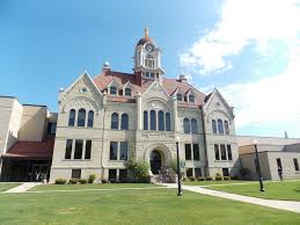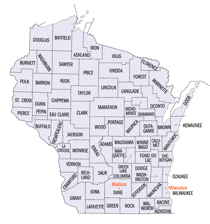Wisconsin Counties
There are seventy-two counties in the state of Wisconsin. Wisconsin became part of the Territory of Michigan and divided into two counties: Brown County in the northeast along Lake Michigan and Crawford County in the southwest along the Mississippi River. The state of Wisconsin was created from Wisconsin Territory on May 29, 1848, with 28 counties.Oconto County, Wisconsin
Oconto County Education, Geography, and History

Oconto County is a county in the state of Wisconsin. Based on the 2010 census, the population was 37,660. Its county seat is Oconto. The
county was established in 1851.
Oconto County is part of the Green Bay, WI Metropolitan Statistical Area as well as the Green Bay-Shawano, WI Combined Statistical Area.
Etymology - Origin of Oconto County Name
Oconto County takes its name from its chief river. The significance of this word is variously given as "red ground," or "the place of the pickerel" in Gannett, Place Names, p. 194; or the Menominee word for "black bass" in Legler, Wis. Place Names. The latter would seem to be correct, since upon many of the early maps (1820-50) the stream is noted as Black Bass River.
[Source: Kellogg, Louise Phelps. "Derivation of County Names" in Proceedings of the State Historical Society of Wisconsin for 1909, pages 219-231.]
Demographics:
County QuickFacts: CensusBureau Quick Facts
Oconto County History
Oconto County, created in 1851 from unorganized territory, is named for an Indian settlement and a river whose
name means "plentiful with fish." Located in northeast Wisconsin, the county seat is Oconto.
John W. Hunt's 1853 Wisconsin Gazetteer
"OCONTO, County, is bounded on the north by the State line, on the east by the middle of Green Bay, and a portion of Brown, on the south by Brown and Outagamie, and on the west by Waupacca and Marathon. It was set off and established from Brown, February 6, 1851, and organized for county purposes April 7, 1852. The principal rivers are Peshtego, Oconto, Pensaukee, and Little Suamico. The judicial connection of Oconto is with Brown, and representative with Outagamie. The chief product of this county, thus far, has been pine lumber, which is produced in great quantities; but little is known of its agricultural advantages."
OCONTO.--Population 1,502.
From: Handbook of Wisconsin by S. Silas, 1855
pg. 90-91
This is another of those large Counties partly surveyed, extending along Green Bay and Michigan, and occupying a certain unknown and almost unexplored, extent. It is well watered, and possesses extensive water powers and several navigable streams, at present but little used except for floating down pine lumber, now nearly the only riches of the County. It is sparsely settled, most of it yet unsurveyed, and the land for agricultural purposes is said to be very poor; yet there are undoubtedly good farming lands to be found, and its facilities for reaching market will soon induce a heavy population. A steamer runs from Green Bay up the Oconto, and from Oshkosh up the Wolf, nearly to the southern line of the County. Nearly the whole of Oconto is in the Menasha land district, one range being in the Stevens Point.
A new Post Office has been established at Pensaukie, a prosperous lumber station on the Oconto, about 20 miles from
Green Bay, and is on the route of the Green Bay, Menomonee and Lake Superior mail.
Geography: Land and Water
As reported by the Census Bureau, the county has a total area of 1,149 square miles (2,976 km2), of which, 998 square miles (2,585 km2) of it is land and 151 square miles (391 km2) of it (13.15%) is water.
Neighboring Counties
Bordering counties are as follows:
- Marinette County - northeast
- Brown County - south
- Shawano County - southwest
- Menominee County - west
- Langlade County - west
- Forest County - northwest
Education







